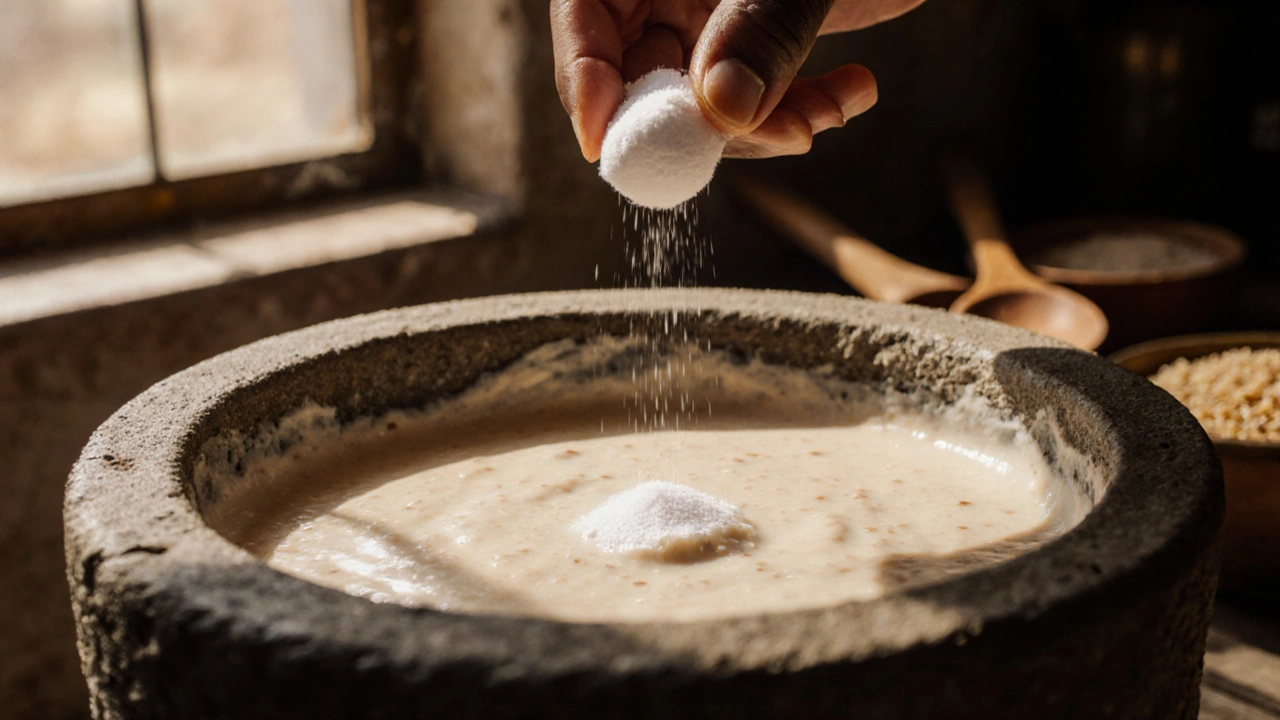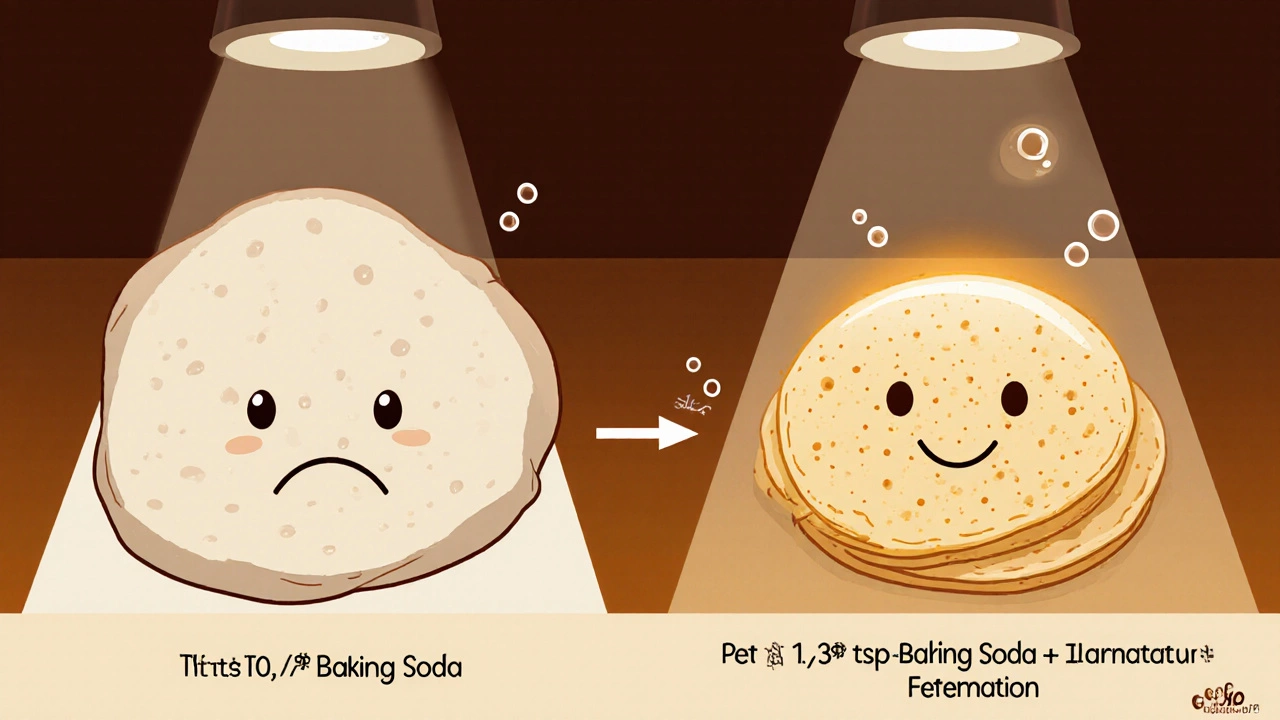How Much Baking Soda to Add to Dosa Batter for Perfect Fluffiness
 Nov, 16 2025
Nov, 16 2025
Dosa Baking Soda Calculator
Perfect Fluffiness Calculator
Based on article recommendation: 1/4 teaspoon baking soda per 2 cups dry ingredients
Recommended Baking Soda:
1/4 teaspoon per 2 cups
Pro Tip: For best results, use this amount 10-15 minutes before cooking. Too much baking soda causes a soapy taste.
Ever made dosa batter, let it sit overnight, and ended up with flat, rubbery dosas instead of light, crispy ones? You’re not alone. The problem isn’t always the fermentation-it’s often how much baking soda you add, or if you add it at all. Baking soda isn’t a substitute for fermentation, but when used right, it’s the secret weapon for that airy, golden texture every dosa should have.
Why Baking Soda Goes in Dosa Batter
Baking soda, or sodium bicarbonate, reacts with acids to produce carbon dioxide. In dosa batter, the natural lactic acid from fermentation activates it. That gas gets trapped in the batter, making it puff up when it hits the hot griddle. Without it, even well-fermented batter can turn out dense, especially in cooler climates or if your rice isn’t soaked long enough.
But here’s the catch: too much baking soda leaves a soapy, metallic aftertaste. Too little, and your dosas won’t rise. The sweet spot is tiny-just enough to lift, not to overwhelm.
The Right Amount: A Measured Pinch
For every 2 cups of dry rice and lentils combined (roughly 400-450g total), use 1/4 teaspoon of baking soda. That’s about the size of a small pea or the tip of a knife. This ratio works whether you’re using urad dal and idli rice, or a mix of parboiled rice and chana dal.
Some cooks add it before fermentation. Others wait until just before cooking. Both work, but timing matters.
- Add before fermentation: Mix it in with the batter right after grinding. This helps the gas develop slowly during the 8-12 hour rise. Best for humid climates or if your batter ferments fast.
- Add just before cooking: Stir it in gently 10-15 minutes before making dosas. This gives you more control. Ideal if you’re unsure about fermentation strength or cooking in a cold kitchen.
Don’t stir it in too hard. You want to keep the air bubbles the fermentation created. Fold it in gently, like you’re mixing a cake batter.
When Not to Use Baking Soda
If your batter is already fluffy and smells tangy after 12 hours of fermentation, skip the baking soda. You don’t need it. Adding it anyway risks a bitter taste and can make the dosas brown too fast.
Also, avoid it if you’re using store-bought dosa mix. Most already contain leavening agents. Adding more can make the batter rise too fast, then collapse. Always check the ingredients list first.

Signs You Used Too Much
Here’s how to tell if you overdid it:
- The batter smells like soap or ammonia, even before cooking.
- The dosas turn dark brown too quickly, even on medium heat.
- You get a chalky or bitter aftertaste.
- The batter bubbles violently when you stir it-like soda pop.
If any of these happen, your next batch should skip baking soda entirely. Let fermentation do its job.
What If Your Batter Won’t Ferment?
Some people reach for baking soda because their batter didn’t rise. That’s a band-aid fix. Fermentation isn’t just about fluff-it’s about flavor. Lactic acid bacteria break down starches, making the batter easier to digest and giving dosas their signature tang.
If your batter isn’t fermenting:
- Check the temperature. Ideal range: 28-32°C (82-90°F). In winter, place the bowl near a warm appliance or wrap it in a towel near a heater.
- Use filtered water. Chlorine kills good bacteria. Tap water can slow or stop fermentation.
- Try adding 1 tablespoon of cooked rice to the batter before grinding. It adds natural sugars that feed the bacteria.
- Let it sit longer-up to 16 hours in cool weather.
Baking soda won’t fix bad fermentation. It’ll just mask it with a chemical taste.

Pro Tips for Perfect Dosa Batter Every Time
- Soak rice and urad dal separately. Rice needs 4-6 hours; urad dal needs 3-4. Don’t soak them together.
- Grind the dal first until fluffy, then add rice. This traps more air.
- Use a heavy-bottomed pan or cast iron griddle. It holds heat evenly, so dosas crisp up without burning.
- Test one dosa before making a full batch. If it’s too thick or doesn’t spread, thin the batter with water.
- Store leftover batter in the fridge for up to 5 days. Bring to room temperature before cooking. Stir gently-don’t re-whip.
Common Mistakes and Fixes
Mistake: Using baking powder instead of baking soda.
Fix: Baking powder contains acid and won’t react the same way. Stick to pure sodium bicarbonate.
Mistake: Adding salt before fermentation.
Fix: Salt slows down yeast and bacteria. Add it after fermentation, just before cooking.
Mistake: Using cold batter straight from the fridge.
Fix: Let it sit for 30 minutes. Cold batter won’t spread or puff properly.
Final Rule of Thumb
If you’re unsure, start with 1/4 teaspoon per 2 cups of dry ingredients. Taste one dosa. If it’s perfect-light, crisp, slightly tangy-then you’ve nailed it. If it’s flat or bland, try extending fermentation next time. If it’s bitter, skip the baking soda entirely.
Great dosas aren’t about tricks. They’re about balance-between time, temperature, and just a whisper of baking soda.
Can I use baking powder instead of baking soda in dosa batter?
No, baking powder isn’t a direct substitute. It contains both baking soda and an acid, which changes how it reacts. In dosa batter, you need the acid to come from natural fermentation. Baking powder may cause uneven rising and leave a chemical aftertaste. Stick to pure baking soda for best results.
How long should I ferment dosa batter before adding baking soda?
Let the batter ferment for at least 8-12 hours at room temperature. If you’re adding baking soda before fermentation, mix it in right after grinding. If you’re adding it just before cooking, wait until the batter has visibly doubled in volume and smells slightly sour. That’s your sign it’s ready.
Why are my dosas not crispy even after adding baking soda?
Crispiness comes from heat and batter consistency, not just baking soda. Make sure your griddle is hot enough-when you sprinkle water on it, it should sizzle and evaporate instantly. Also, thin the batter slightly with water if it’s too thick. A thicker batter steams instead of crisping.
Can I add baking soda to store-bought dosa mix?
Usually not. Most commercial mixes already contain leavening agents like baking soda or ammonium bicarbonate. Adding more can cause over-rising, leading to flat or bitter dosas. Always check the ingredient list first. If it says ‘raising agents,’ skip extra baking soda.
What happens if I forget to add baking soda?
Your dosas will still be edible if the batter fermented well-they’ll just be denser and less airy. In warm climates, fermentation often produces enough lift on its own. You might need to cook them a bit longer to get crisp edges, but they’ll still taste authentic. Baking soda is optional, not mandatory.
